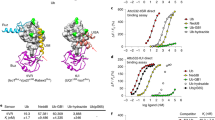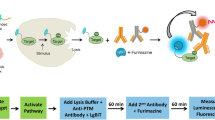Abstract
Despite intensive research, there is a distinct lack of methodology for visualizing endogenous ubiquitination in living cells. In this protocol, we describe how unique properties of ubiquitin (Ub)-binding domains (UBDs) can be used to selectively detect, visualize and inhibit Ub-dependent processes in mammalian cells. The procedure deals with designing and validating the binding selectivity of GFP-tagged K63- and linear-linked sensors (TAB2 NZF and NEMO UBAN, respectively) in vitro. We describe how these moieties can be used to inhibit tumor necrosis factor (TNF)-mediated NF-κB signaling and to detect ubiquitinated cytosolic Salmonella in living cells, emphasizing a more flexible use compared with chain-specific antibodies. These chain-specific sensors can be used to detect Ub-like or autophagy-related modifiers and, in combination with mass spectrometry, to identify new Ub targets. These Ub (-like) sensors can be designed, constructed and tested in ∼2–3 weeks.
This is a preview of subscription content, access via your institution
Access options
Subscribe to this journal
Receive 12 print issues and online access
$259.00 per year
only $21.58 per issue
Buy this article
- Purchase on Springer Link
- Instant access to full article PDF
Prices may be subject to local taxes which are calculated during checkout



Similar content being viewed by others
References
Hershko, A. & Ciechanover, A. The ubiquitin system. Annu. Rev. Biochem. 67, 425–479 (1998).
Ikeda, F. & Dikic, I. Atypical ubiquitin chains: new molecular signals. 'Protein Modifications: Beyond the Usual Suspects' review series. EMBO Rep. 9, 536–542 (2008).
Iwai, K. & Tokunaga, F. Linear polyubiquitination: a new regulator of NF-B activation. EMBO Rep. 10, 706–713 (2009).
Finley, D. Recognition and processing of ubiquitin-protein conjugates by the proteasome. Annu. Rev. Biochem. 78, 477–513 (2009).
Ulrich, H.D. & Walden, H. Ubiquitin signalling in DNA replication and repair. Nat. Rev. Mol. Cell Biol. 11, 479–489 (2010).
Piper, R.C. & Lehner, P.J. Endosomal transport via ubiquitination. Trends Cell Biol. 21, 647–655 (2011).
Husnjak, K. & Dikic, I. Ubiquitin-binding proteins: decoders of ubiquitin-mediated cellular functions. Annu. Rev. Biochem. 81, 291–322 (2012).
Dikic, I., Wakatsuki, S. & Walters, K.J. Ubiquitin-binding domains—from structures to functions. Nat. Rev. Mol. Cell Biol. 10, 659–671 (2009).
Randles, L. & Walters, K.J. Ubiquitin and its binding domains. Front. Biosci. 17, 2140–2157 (2012).
Kulathu, Y., Akutsu, M., Bremm, A., Hofmann, K. & Komander, D. Two-sided ubiquitin binding explains specificity of the TAB2 NZF domain. Nat. Struct. Mol. Biol. 16, 1328–1330 (2009).
Rahighi, S. et al. Specific recognition of linear ubiquitin chains by NEMO is important for NF-B activation. Cell 136, 1098–1109 (2009).
Kulathu, Y. & Komander, D. Atypical ubiquitylation—the unexplored world of polyubiquitin beyond Lys48 and Lys63 linkages. Nat. Rev. Mol. Cell Biol. 13, 508–523 (2012).
Xu, P. et al. Quantitative proteomics reveals the function of unconventional ubiquitin chains in proteasomal degradation. Cell 137, 133–145 (2009).
Phu, L. et al. Improved quantitative mass spectrometry methods for characterizing complex ubiquitin signals. Mol. Cell Proteomics 10, M110 003756 (2011).
Gerlach, B. et al. Linear ubiquitination prevents inflammation and regulates immune signalling. Nature 471, 591–596 (2011).
Haas, T.L. et al. Recruitment of the linear ubiquitin chain assembly complex stabilizes the TNF-R1 signaling complex and is required for TNF-mediated gene induction. Mol. Cell 36, 831–844 (2009).
Ikeda, F. et al. SHARPIN forms a linear ubiquitin ligase complex regulating NF-B activity and apoptosis. Nature 471, 637–641 (2011).
Tokunaga, F. et al. SHARPIN is a component of the NF-B–activating linear ubiquitin chain assembly complex. Nature 471, 633–636 (2011).
Laney, J.D. & Hochstrasser, M. Analysis of protein ubiquitination. Curr. Protoc. Protein Sci. 66, 14.5.1–14.5.13 (2011).
Argenzio, E. et al. Proteomic snapshot of the EGF-induced ubiquitin network. Mol. Syst. Biol. 7, 462 (2011).
Dohmen, R.J. & Scheffner, M. Methods in Molecular Biology 832 (ed. Walker, J.M.) 1–660 (Humana Press, 2012).
Kirkpatrick, D.S., Denison, C. & Gygi, S.P. Weighing in on ubiquitin: the expanding role of mass-spectrometry-based proteomics. Nat. Cell Biol. 7, 750–757 (2005).
Povlsen, L.K. et al. Systems-wide analysis of ubiquitylation dynamics reveals a key role for PAF15 ubiquitylation in DNA-damage bypass. Nat. Cell Biol. 14, 1089–1098 (2012).
Wagner, S.A. et al. Proteomic analyses reveal divergent ubiquitylation site patterns in murine tissues. Mol. Cell Proteomics 11, 1578–1585 (2012).
Xu, G., Paige, J.S. & Jaffrey, S.R. Global analysis of lysine ubiquitination by ubiquitin remnant immunoaffinity profiling. Nat. Biotechnol. 28, 868–873 (2010).
Wagner, S.A. et al. A proteome-wide, quantitative survey of in vivo ubiquitylation sites reveals widespread regulatory roles. Mol. Cell Proteomics 10, M111 013284 (2011).
Emanuele, M.J. et al. Global identification of modular cullin-RING ligase substrates. Cell 147, 459–474 (2011).
Kirkpatrick, D.S., Gerber, S.A. & Gygi, S.P. The absolute quantification strategy: a general procedure for the quantification of proteins and post-translational modifications. Methods 35, 265–273 (2005).
Fujimuro, M. & Yokosawa, H. Production of antipolyubiquitin monoclonal antibodies and their use for characterization and isolation of polyubiquitinated proteins. Methods Enzymol. 399, 75–86 (2005).
Matsumoto, M.L. et al. K11-linked polyubiquitination in cell cycle control revealed by a K11 linkage-specific antibody. Mol. Cell 39, 477–484 (2010).
Matsumoto, M.L. et al. Engineering and structural characterization of a linear-polyubiquitin-specific antibody. J. Mol. Biol. 418, 144 (2011).
Newton, K. et al. Ubiquitin chain editing revealed by polyubiquitin linkage-specific antibodies. Cell 134, 668–678 (2008).
Erpapazoglou, Z. et al. A dual role for K63-linked ubiquitin chains in multivesicular body biogenesis and cargo sorting. Mol. Biol. Cell 23, 2170–2183 (2012).
van Wijk, S.J. et al. Fluorescence-based sensors to monitor localization and functions of linear and K63-linked ubiquitin chains in cells. Mol. Cell 47, 797–809 (2012).
Sims, J.J. et al. Polyubiquitin-sensor proteins reveal localization and linkage-type dependence of cellular ubiquitin signaling. Nat. Methods 9, 303–309 (2012).
Chen, J. & Chen, Z.J. Regulation of NF-B by ubiquitination. Curr. Opin. Immunol. 25, 4–12 (2013).
Grabbe, C., Husnjak, K. & Dikic, I. The spatial and temporal organization of ubiquitin networks. Nat. Rev. Mol. Cell Biol. 12, 295–307 (2011).
Wild, P. et al. Phosphorylation of the autophagy receptor optineurin restricts Salmonella growth. Science 333, 228–233 (2011).
Thurston, T.L., Ryzhakov, G., Bloor, S., von Muhlinen, N. & Randow, F. The TBK1 adaptor and autophagy receptor NDP52 restricts the proliferation of ubiquitin-coated bacteria. Nat. Immunol. 10, 1215–1221 (2009).
Huett, A. et al. The LRR and RING domain protein LRSAM1 is an E3 ligase crucial for ubiquitin-dependent autophagy of intracellular Salmonella Typhimurium. Cell Host Microbe 12, 778–790 (2012).
Bumann, D. & Valdivia, R.H. Identification of host-induced pathogen genes by differential fluorescence induction reporter systems. Nat. Protoc. 2, 770–777 (2007).
van Wijk, S.J., Muller, S. & Dikic, I. Shared and unique properties of ubiquitin and SUMO interaction networks in DNA repair. Genes Dev. 25, 1763–1769 (2011).
McEwan, D.G. & Dikic, I. The Three Musketeers of autophagy: phosphorylation, ubiquitylation and acetylation. Trends Cell Biol. 21, 195–201 (2011).
Kirchhofer, A. et al. Modulation of protein properties in living cells using nanobodies. Nat. Struct. Mol. Biol. 17, 133–138 (2010).
van de Linde, S., Heilemann, M. & Sauer, M. Live-cell super-resolution imaging with synthetic fluorophores. Annu. Rev. Phys. Chem. 63, 519–540 (2012).
Nelson, D.E. et al. Oscillations in NF-B signaling control the dynamics of gene expression. Science 306, 704–708 (2004).
Acknowledgements
We thank A. Bremm, D. McEwan and J. Lopez for critical reading of the manuscript. This work was supported by the Cluster of Excellence 'Macromolecular Complexes' of the Goethe University, Frankfurt am Main (EXC115); LOEWE Oncology Signaling Network and LOEWE Center for Cell and Gene Therapy, Frankfurt am Main; and a European Research Council Advance Grant (I.D).
Author information
Authors and Affiliations
Contributions
S.J.L.v.W. was involved in development of the protocol and prepared the manuscript. E.F. supported with Salmonella imaging and edited the manuscript. I.D. is the principal investigator who supervised the work and edited the manuscript.
Corresponding author
Ethics declarations
Competing interests
The authors declare no competing financial interests.
Supplementary information
Supplementary Figure 1
Schematic representation of potential sensors for Ub, UBLs and autophagy-like modifiers (PDF 598 kb)
Supplementary Figure 2
Schematic representation of mammalian Ub sensors used in this protocol (PDF 582 kb)
Supplementary Figure 3
Stably expressed GFP NEMO UBAN co localizes with Ub chain specific antibodies on Infected Salmonella (PDF 620 kb)
Supplementary Figure 4
Expression of TAB2 NZF E685A does not affect TNF induced NF-κB signalling (PDF 616 kb)
Supplementary Video 1
Recruitment of linear Ub chain-specific NEMO UBAN to cytosolic Salmonella in living cells (AVI 1951 kb)
Rights and permissions
About this article
Cite this article
van Wijk, S., Fiškin, E. & Dikic, I. Selective monitoring of ubiquitin signals with genetically encoded ubiquitin chain–specific sensors. Nat Protoc 8, 1449–1458 (2013). https://doi.org/10.1038/nprot.2013.089
Published:
Issue Date:
DOI: https://doi.org/10.1038/nprot.2013.089
This article is cited by
-
An expanded lexicon for the ubiquitin code
Nature Reviews Molecular Cell Biology (2023)
-
The HOIL-1L ligase modulates immune signalling and cell death via monoubiquitination of LUBAC
Nature Cell Biology (2020)
-
Linear ubiquitination of cytosolic Salmonella Typhimurium activates NF-κB and restricts bacterial proliferation
Nature Microbiology (2017)
Comments
By submitting a comment you agree to abide by our Terms and Community Guidelines. If you find something abusive or that does not comply with our terms or guidelines please flag it as inappropriate.



